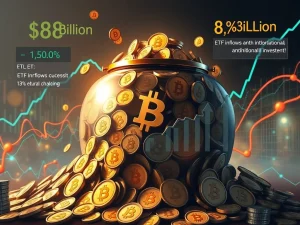Urgent: Can Bitcoin’s 21 Million Cap Survive Quantum Threat with QRAMP?

Bitcoin’s 21 million supply limit is a core feature, defining its scarcity and appeal. But what happens when powerful new threats emerge? Specifically, how does the world’s leading cryptocurrency address the challenge of quantum computing and the growing demand for cross-chain utility? This is where the QRAMP protocol comes into play.
Understanding the QRAMP Protocol
Proposed in early 2025, the QRAMP protocol, short for quantum-resistant asset mapping protocol, is a framework designed to tackle two major future challenges for Bitcoin. It aims to protect Bitcoin from potential quantum attacks and provide a safer way to use Bitcoin across different blockchain ecosystems without risking custody or violating the supply limit.
Unlike wrapped Bitcoin variants (like WBTC or renBTC) that rely on custodians to hold actual BTC and issue tokens elsewhere, QRAMP uses cryptographic attestations. These proofs, derived from the Bitcoin timechain, verify BTC balances on external systems without the original coins ever leaving the Bitcoin network. Think of it as a verifiable digital twin or hologram of your Bitcoin, accessible elsewhere but anchored to the base layer.
Advanced QRAMP implementations could integrate zero-knowledge (ZK) proofs, such as SNARKs. This allows verification of ownership and balances without revealing sensitive transaction details. This technology enables non-custodial synthetic Bitcoin assets that can operate on layer 2 solutions, alternative layer 1s, or even post-quantum blockchains, all while maintaining a cryptographic link to the main Bitcoin chain.
Why is Quantum Computing a Threat to Bitcoin?
Bitcoin’s current security relies on the Elliptic Curve Digital Signature Algorithm (ECDSA). While secure today, a sufficiently powerful quantum computer could potentially break ECDSA using algorithms like Shor’s algorithm. This could allow attackers to derive private keys from public keys, especially for older wallets where public keys are exposed on-chain. This puts substantial amounts of dormant BTC at risk.
Major financial players are acknowledging this risk. In 2025, BlackRock reportedly updated its iShares Bitcoin Trust filing to warn investors about the potential for quantum technology to undermine Bitcoin’s cryptographic protections and network integrity. This is precisely the scenario the QRAMP protocol intends to mitigate. It offers a structured path to migrate BTC to quantum-safe addresses and mirror balances across future post-quantum chains, preserving the 21 million cap and avoiding centralized custodians.
Experts estimate quantum computers capable of breaking current cryptography could arrive within 10 to 20 years, with some private forecasts suggesting it could be sooner. Addressing this potential vulnerability is becoming increasingly urgent for long-term cryptocurrency security.
Can Synthetic Bitcoin Assets Break the 21 Million Supply Cap?
A natural concern arises: could creating synthetic Bitcoin assets on other chains lead to a fractional reserve system or inflate the perceived supply, thus breaking the 21 million limit? If mirrored versions of BTC circulate across multiple chains, doesn’t that undermine scarcity?
Crucially, QRAMP does not expand the underlying supply of Bitcoin. It does not mint new BTC or hold coins in custody. Instead, it uses cryptographic attestations – proofs derived from the Bitcoin timechain or potentially ZK-proofs – to ensure that synthetic representations correspond directly to real, unspent BTC on the base layer. The system is designed for transparent tethering of each synthetic unit to actual BTC, without needing a custodian for enforcement.
Therefore, QRAMP is not a fractional reserve system. It functions as a non-custodial mirror. Its purpose is to extend Bitcoin’s utility in a composable and future-proof way while strictly respecting the hard cap and avoiding centralized trust assumptions. While it might influence scarcity perception in certain market contexts, QRAMP itself does not break the 21-million limit; it preserves it.
How the QRAMP Protocol Aims to Work
Implementing QRAMP would be a significant undertaking. The protocol proposes migrating Bitcoin’s Unspent Transaction Outputs (UTXOs) from current, potentially vulnerable cryptography to new quantum-resistant addresses.
The proposed process involves:
- Identifying Vulnerable Addresses: Pinpointing Bitcoin addresses exposed to quantum risk, primarily those with visible public keys.
- Burn and Replace: Users send coins from these addresses to a special ‘quantum burn’ address, rendering them unspendable. An equal amount of new, quantum-resistant BTC is issued in return.
- Post-Quantum Security: The newly issued coins utilize advanced cryptography resistant to quantum attacks, such as hash-based signatures or lattice-based algorithms.
- Proof-Based Verification: Only verified ‘burns’ trigger the issuance of new coins, ensuring a strict 1:1 conversion and preventing inflation or fraud.
This migration would incorporate post-quantum cryptographic primitives. Key families include:
- Lattice-based cryptography: Examples like Crystals-Dilithium or Falcon, based on mathematical problems thought to be resistant to quantum decryption.
- Hash-based signature schemes: Like Sphincs+, which use robust one-time signatures secured by proven hash functions.
Executing this plan requires a hard fork, a fundamental change to Bitcoin’s consensus rules. This necessitates broad community consensus, miner support, and wallet compatibility. The social hurdle of achieving widespread agreement and adoption is arguably the biggest challenge, more significant than the technical implementation itself.
Furthermore, QRAMP requires user action. Non-participation during a proposed mandatory migration period could result in permanent loss of funds. Education, clear tools, and incentives would be crucial for successful user compliance.
Bitcoin’s Quantum Gamble vs. Other Cryptocurrency Security Approaches
Bitcoin is not alone in considering the quantum future. Other projects are also exploring or implementing quantum-resistant solutions. Comparing QRAMP’s approach provides perspective on cryptocurrency security in a post-quantum world.
Here’s how QRAMP compares to some other initiatives:
| Project/Approach | Method | Status | Key Difference from QRAMP |
|---|---|---|---|
| Ethereum Post-Quantum Research | Investigating hash-based (Sphincs+, XMSS) and lattice-based (Dilithium, Falcon) schemes via Account Abstraction. | Research/Theoretical | Likely opt-in via account abstraction, not a protocol-level mandatory migration. |
| Quantum-Resistant Ledger (QRL) | Purpose-built blockchain using XMSS signature scheme. | Operational | An entirely new chain, not a migration plan for an existing large network like Bitcoin. |
| Solana Quantum Vaults | Optional vaults using Winternitz one-time signature schemes. | Early Stage/Opt-in | An optional feature for asset storage, not a mandatory protocol-wide address migration. |
| QRAMP Protocol (Proposed) | Mandatory migration of UTXOs using quantum-resistant cryptography via hard fork. | Proposed | Protocol-level mandatory enforcement treating quantum risk as a systemic emergency. |
QRAMP’s distinction lies in its proposed mandatory enforcement. It’s presented as a systemic solution requiring network-wide participation to ensure long-term cryptocurrency security against quantum threats.
Conclusion
The QRAMP protocol represents an ambitious proposal to address significant future challenges for Bitcoin: the threat of quantum computing and the need for secure cross-chain utility. By proposing a mechanism to migrate Bitcoin’s cryptography and enable non-custodial synthetic assets, it aims to preserve the network’s core principles, including the 21 million supply cap, in a changing technological landscape.
Whether QRAMP or a different approach is ultimately adopted by the Bitcoin community remains uncertain. However, the proposal signals that Bitcoin developers are taking quantum threats seriously. The clock is ticking, and the discussion around solutions like QRAMP highlights the ongoing effort to ensure Bitcoin’s resilience and relevance long into the future.










